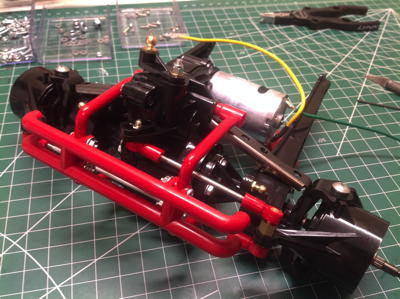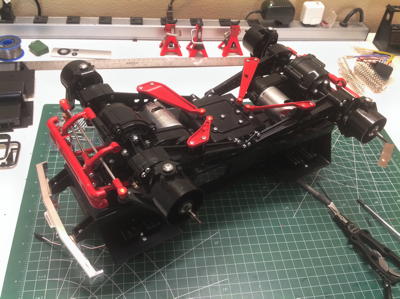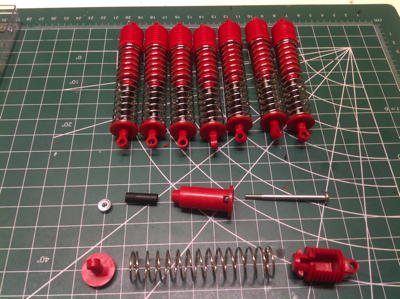The Clod box is huge. It is among the biggest Tamiya boxes I have
seen, equivalent to those of the 1/14th scale tractor trucks. A
look inside reveals that much of this space is consumed by the
tires. The box of the black edition is considerably more plain
than the standard Super Clod Buster with no hand drawn art. A
dark, grayscale photograph is used instead.
Here are the parts laid out on my build table. Everything is
identical to the regular edition except that the suspension parts which
are blue on the original are red here.
I was using a pathetic Futaba S3004 servo as a placeholder until I got
something better, but I found that it actually works just fine.
Given that the steering system has been unchanged for 30 years and there
really wasn't any such thing as a "high torque" servo back then, the
truck was actually designed for something like this. Yes the
torque is low and the tires are huge, but the natural forces on the
steered back wheels tend to balance the forces on the front wheels such
that very little torque is actually required. In addition to that,
the sloppy servo savers make a stronger servo moot anyway. This
single servo will sit in the middle of the chassis and steer both
axles. See the picture on the right for the long steering links.
Yes, the chassis is the same molded part from all the way back in
1987. It is used slightly differently since there is no mechanical
speed controller now, but the basic part is the same.
The link attachment points were a known weakness in the original model,
so these metal plates have been added to the newer editions as
reinforcements. The ball connectors are much larger than your
standard Tamiya. The brass colored balls on the bottom of the
chassis are 6mm and are for the upper links. The silver colored
balls on the sides of the chassis are 8mm and are for the trailing arms.
Now a couple of cross members can be installed by the shock attachment
locations. This will stiffen the chassis against flex when the
shocks absorb an impact. The body posts are built into these same
locations. The front chrome bumper is also installed now.
Note the faux winch fairlead. On the right you can see the
installed steering servo.
Time to start building the massive axles. The outer hubs are
massive and come in two lengths. The kit includes ball bearings
for use at the inner axle support and plastic bushings for the outer
support. Plastic bushings are clearly unacceptable. I wanted
to leave this build as close to stock as possible so I grabbed some
unused bushings for the outer supports. The axles are steel
dogbones. On the right you can see the hubs attached to the
gearbox housings. There is a lot going on in these axles.
Most RCs have a gearbox mounted somewhere on the chassis, but the Clod
Buster uses two identical but independent gearboxes attached to the
axles. These are some truly massive gears that can handle a lot of
power. Look at the size of the three spider gears in the
differential on the right. All of this seems unchanged from the
original Clod as far as I can tell.
After greasing the gears, the two gearbox halves can be joined with five
screws as shown on the left. All of the screws use nuts so they
don't thread into plastic. On the right you see that the motor has
been installed. This is a standard silver can with a 13T aluminum
pinion (which I replaced with steel). No other pinion size is
possible. Note that the Clod runs one of the two motors backward
so it is not easy to change to motors with advanced timing since one of
them will actually be retarded instead. To use timed motors, you
need to use a variety that allows reverse timing. I'm sticking
with the stock motors on this model.
Now the gigantic trailing arms can be installed. You can see the
hemispherical sockets in the ends of the link. These fit onto the
balls on the axle housings which can be seen in previous photos.
The Clod uses a strange suspension type because the upper triangulated
arms actually attach to the lower arms, not to the axle. The red
upper arms are easily seen on the left. One effect of this
geometry is that the suspension is technically kinematically
locked. Twist of the suspension can only happen by deforming the
red parts. On the right you can see that one of these links is
also used as an inboard support for the motor. This results in
less articulation on one side. Also see the metal diagonal braces
which help support the steering hub. The two smaller ball joints
on the top of the arm visible on the right will be used as shock
supports.


The steering knuckles on the Clod Buster are without peer. They
are simply massive. You may notice that the steering link ball
joint is actually quite a bit inboard of the kingpin. Normally,
this would result in Ackerman correction (the wheel on the inside of a
turn has a larger steering angle than the wheel on the outside).
However, because the steering link is actually installed in front of the
axle instead of behind, this correction is backwards (same on the rear
axle in reverse). This is partially responsible for the terrible
steering of the Clod Buster. The picture on the right shows the
nearly identical front and rear axles. The only difference is in
the direction of the crank on the servo saver. Because both of the
steering links from the servo are on the same side of the chassis, the
cranks also need to end up on the same side. The servo savers are
notoriously weak, so I cranked them down much further than recommended.


The red bumpers actually form a structural reinforcement for the
gearboxes as well as providing impact protection. On the right you
can see that I've snapped all the links onto the ball joints on the
chassis, installing the axles. The black trailing arms don't snap
onto the 8mm balls. Instead they are captured by a metal cup
fastened from behind the ball joints so nothing needs to be deformed on
installation. There are no drive shafts! Very odd.


While it is cool that the Clod uses eight shock absorbers, it is not
cool how pathetic they are. There is no oil and not even any
rubber tubing for damping. These are just pogo sticks.
Still, the undamped bouncing is part of the charm of driving a Clod
Buster. You can see the installed shocks on the right. The
rectangular "pods" sticking out the side of the chassis are the covers
for the laterally mounted battery. In the original version, there
would have been an upper plate on the chassis tub holding the MSC, the
receiver, the receiver battery, and the resistor.


Clod Buster wheels use 12mm hexes, but not in the normal way. A
12mm brass hex adapts to the output spline. This model does not
use cross pins which is a good thing for strength (holes are
weak). The wheel does not have a 12mm hex recess. Instead,
the black wheel adapter mates with the 12mm hex and provides five holes
which grip studs on the inner face of the wheels. This spreads the
torque over a much larger diameter. Finally, the massive tires
can be installed on the wheels. The black edition uses the same
tires as always, but the wheels use a different type of blackened chrome
finish.
I painted the body in standard black and then put a clear coat over the
stickers. The stickers are unique to the black edition. This
is the same body as the original Clod but lacking the Chevy bow tie
like the Super Clod Buster. Other than that, everything is like
the original.
And here's the completed truck in all of its historical (and now limited edition) glory.